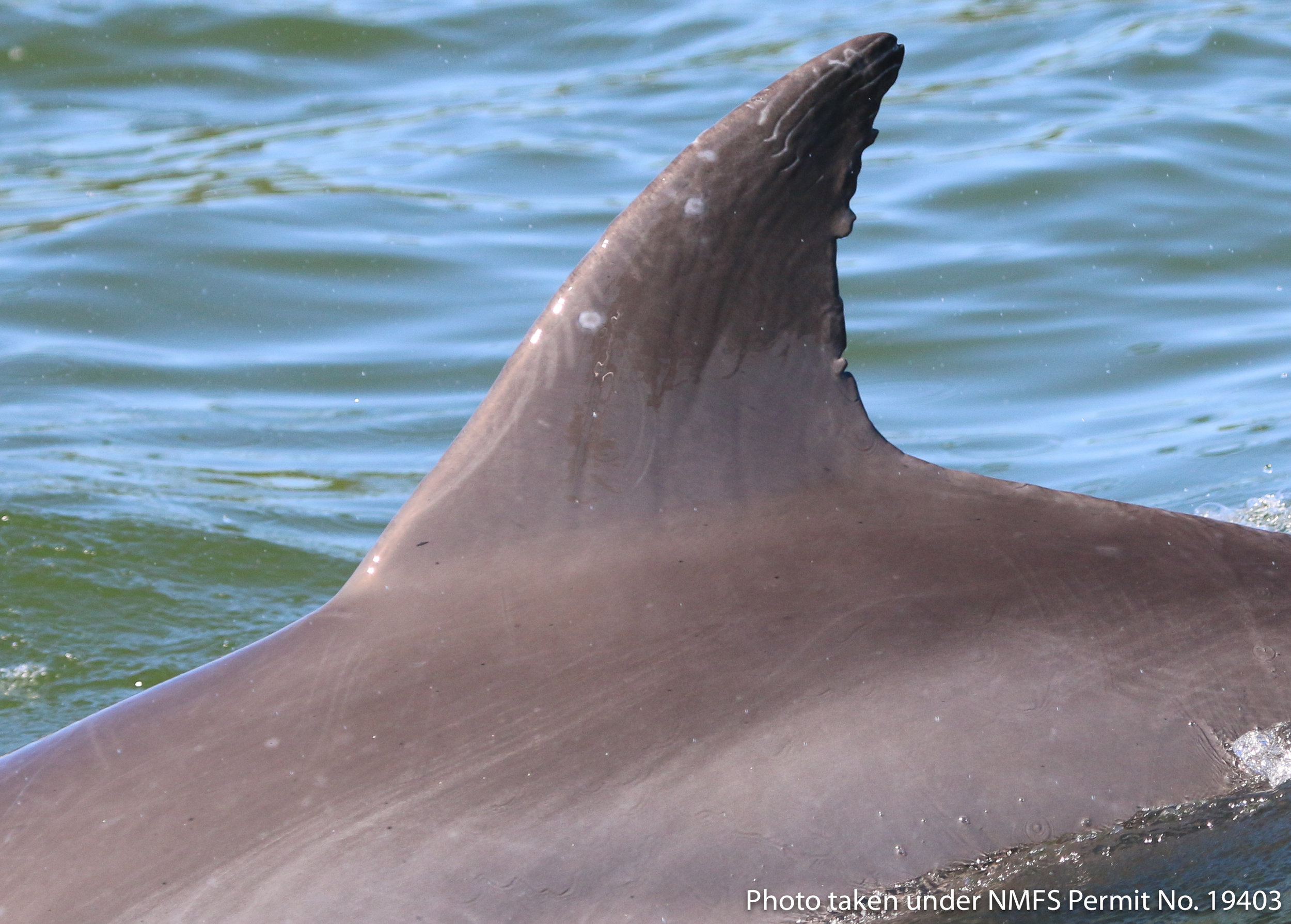UPDATE JUNE 2019
With over 1,400 ballots cast, the public voted
to name two Potomac River dolphins…
Mac and Chessie!
The bottlenose dolphins formally known as D1 and D2 are dolphin-ately in love with their new names!
How could they not? With 27% of the vote, the public voted to name them in honor of the local waterways they explore during the summer: the Potomac “Mac” River and the Chesapeake “Chessie” Bay.
Potomac Conservancy and the Potomac-Chesapeake Dolphin Project thank everyone who participated in our first dolphin naming contest. And we give special thanks to those who boosted their vote with a charitable donation!
Final Vote Results:
Mac and Chessie 27%
Cherry and Blossom 16%
Ebb and Flow 14%
Powhatan and Piscataway 10%
Echo and Radar 10%
Rachel Carson and Sylvia Earle 8%
Harriet Tubman and Frederick Douglass 6%
Madeleine Paddlin’ Albright and Colin Divin’ Powell 5%
Benjamin Banneker and Pierre L’Enfant 1%
Aldo Leopold and Wendell Berry 1%
Now, let’s take the next step.
Give today and help protect Mac and Chessie!
We’d like to see the dolphins come back to the Potomac each year to birth and raise calves. But, increasing levels of pollution from litter and polluted runoff doesn't make it easy for them.
Make a $25, $50, or $100 charitable gift today and help fund year-round cleanup programs that remove plastic and trash from the Potomac River.
Mac and Chessie are counting on all of us to chip in!
Here were the top 10 picks
Rachel Carson and Sylvia Earle
Biologist and Silver Spring, Maryland native Rachel Carson (1907-1964), inspired a generation to treasure aquatic environments with her books about the wonders of the sea. Her final book, Silent Spring, sparked the modern environmental movement and alerted the world to the effects of pesticides on wildlife. Sylvia Alice Earle (b. 1935), a renowned marine biologist, was the first female chief scientist of the U.S. National Oceanic and Atmospheric Administration. Earle was awarded the Norwegian Rachel Carson Prize in 2017 in recognition for her work as a trailblazing oceanographer, explorer, and author.
Mac and Chessie
Shorthand for Potomac and Chesapeake, the local waterways where D1, D2, and hundreds of their fellow Atlantic bottlenose dolphins spend the summer months. Its in these shallow, tidal waters where the dolphins seek safe harbor to birth and raise their young, and voyage back out to the deeper sea in winter.
Powhatan and Piscataway
The Powhatan and Piscataway are indigenous peoples of the Potomac region. Virginia recognizes the Pamunkey, Mattaponi, and six other native groups as having ancestral ties to the Powhatan confederation, originally an affiliation of 30 eastern Virginian tributary peoples. The Piscataway territory includes land that stretches along the Potomac River in what is now D.C.; Prince George’s, Charles, St. Mary’s, Frederick, and Montgomery counties in Maryland; and across the river into Northern Virginia. They were once the most populous native population in the Chesapeake Bay region. Today, the Piscataway Indian Nation and the Piscataway Conoy Tribe are formally recognized by the state of Maryland.
Ebb and Flow
Like the incoming flow and outgoing ebb of the waters of the Potomac River. That’s right, Washington, DC has tides! The Potomac’s fresh water begins to mix with tidal waters near Chain Bridge. As the river widens and expands downstream towards the Chesapeake Bay, its waters become more brackish and support dolphins and other marine life typical of ocean environments.
Harriet Tubman and Frederick Douglass
After fighting to escape slavery, Harriet Tubman (1822-1913) and Frederick Douglass (1818-1895) dedicated their lives to advancing justice, equality, and human rights for African Americans. As a conductor of the underground railroad, Tubman put her life on the line as a liberator, scout, nurse, and soldier to help escaped slaves from the South travel north and secure their freedom. Maryland-born Douglass became a renowned author, national leader of the abolitionist movement, orator, and statesman. His powerful autobiographies influenced others, including President Lincoln, in the battle for abolition and social justice. Today, you can visit the Frederick Douglass home in the historic Anacostia neighborhood of Washington, DC.
Echo and Radar
Echolocation is used by dolphins as a way of "seeing with sound". By bouncing sound waves off of objects and back to their quite large brains, dolphins can find prey (like local American shad) and navigate both the vast ocean and the channel of the Potomac. Radar is a man-made technology that works similarly to echolocation, but dolphins still have us beat-- their natural echolocation is still inspiring improvements in radar technology today.
Aldo Leopold and Wendell Berry
Authors Aldo Leopold (1887-1948) and Wendell Berry (b. 1934) advanced powerful philosophies of conservation and environmental ethics in their renowned works. Considered the founder of wildlife ecology in the United States, Leopold was a conservationist, forester, philosopher, and educator. In one of his best-known works, The Land Ethic, he calls upon us to foster a nurturing, respectful relationship with nature and wildlife. Farmer and prolific writer Wendell Berry has authored over 40 essays, poems, and novels that encourage humans to live in harmony with our environment. In his work The Unsettling of America: Culture and Agriculture, he critically examines the failures of modern, mechanized life and advocates for sustainable agricultural practices as a part of the broader conservation movement.
Cherry and Blossom
Gifted by Japan’s Mayor of Tokyo City in 1912, the cherry blossom trees that line Washington, DC’s Tidal Basin are an iconic and beloved natural wonder that symbolize the renewal of springtime. Each year, visitors from all over the world walk along the water’s edge to experience and capture the soft pink blossoms before the season’s winds force the trees to shed their petals.
Madeleine Paddlin’ Albright and Colin Divin’ Powell
Former US Secretary of States - with a twist. The Potomac-Chesapeake Dolphin Project has assigned over 300 dolphins with names honoring US political leaders, including Barbara Bush and Abraham Lincoln, but notably no dolphin has been honored with Albright or Powell’s name. Could the Potomac dolphins be the face of US diplomatic relations?
Benjamin Banneker and Pierre L’Enfant
Informally called the “Architects of Washington, DC” Banneker and L’Enfant helped shape the District of Columbia, quite literally. Born to a free woman and a former slave in Baltimore County, Banneker (1731-1806) was a self-taught mathematician, naturalist, and almanac author. He used astronomy to map the north-south and east-west quadrants of the Federal District with Major Andrew Ellicott starting in 1791. That same year, L’Enfant (1754-1825), a French-American military engineer, was commissioned by George Washington to design a detailed layout for the future capital city. His design of streets, parks, and canals - bounded by rivers - is known as the L’Enfant Plan for the Federal City.
So wait, there are dolphins in the Potomac River!?
Yes! Experts from the Potomac-Chesapeake Dolphin Project have identified well over 1,000 unique dolphins to-date and believe there could be thousands of dolphins swimming in the Potomac and Chesapeake Bay. In late spring, the dolphins migrate in from the Atlantic Ocean and spend the summer months in the Potomac.
Citizen scientists can also upload their sightings to the Chesapeake Dolphin Watch, a program operated by Chesapeake Biological Laboratory (CBL). The PCDP welcomes sightings and photos of dolphins directly or from CBL for identification.
The return of cleaner water and healthy native fish to the Potomac River may be encouraging these aquatic critters to explore further upstream.
With continued progress and Potomac Conservancy’s clean water initiatives, it's possible that dolphins could be seen near Washington, DC one day! Back in the 1880s, dolphins were regularly seen near Indian Head, Maryland, and some were even spotted as far upstream as Alexandria, Virginia.
Citizen Scientist Dolphin Sightings
Potomac River, 2015-2018
These days, the Potomac dolphins are concentrated in the brackish waters near the mouth of the river where they relax and feast on fish. But, citizen scientists (see map above) have spotted dolphins further upstream, and as far as north as the 301 Harry Nice Memorial Bridge near Dalghren, VA.
The Potomac River plays a special role in the lives of these playful animals: it’s where they birth and raise their calves!
BABY DOLPHINS IN THE POTOMAC, Y’ALL. Just look at them. 😍
BOTTLENOSE DOLPHINS SWIM WITH THEIR CALVES IN THE POTOMAC RIVER. NMFS Permit No. 19403
There’s still much we don’t know about the Potomac River dolphins.
We’re hoping to change that.
Launched in 2015, the Potomac-Chesapeake Dolphin Project (PCDP) studies the dolphins in the hopes of unlocking answers to key questions about their seasonal migration, mating and breeding, feeding habits, ecosystem benefits, and local challenges to their habitat and health.
To help with tracking, each dolphin is assigned a unique name. To date, PCDP has named 304 dolphins with names that honor our country’s past and present leaders including US presidents, vice presidents, first ladies, and Congress members. Last summer, Martha Washington was seen by a 'citizen scientist' with a new calf!
While there is a “Lady Bird Johnson” and an “Abraham Lincoln” swimming around out there, more dolphins like “D1” and “D2” need names! That’s where your creativity comes in!
Meet our Dolphins!
(Identified by their unique dorsal fins)
Mac, formerly D1
Chessie, formerly D2
Click on a pin to bring up more information on a sighting.
Field Notes from the Research Team - April 2019
Potomac-Chesapeake Dolphin Project
”D1 and D2 have been spotted in the Potomac River over the last several years. Both are suspected to be mature adults and neither has been seen with a calf. Why suspected adults? It takes between five and ten years for a bottlenose dolphin calf to reach puberty and mate.
Each time D1 and D2 were sighted, they were seen resting or traveling in groups ranging in size from 20 to 163 dolphins. On August 8, 2016 and August 15, 2017 they were spotted swimming together in the same group.”
Help protect dolphins and local wildlife
that depend on a clean Potomac!
Your donation will support clean water programs that keep pollution out of the Potomac River.
About the Partners
The Potomac-Chesapeake Dolphin Project leads the first study of wild bottlenose dolphins in the Potomac River and Chesapeake Bay. Founding Director Janet Mann, Professor of Biology and Psychology at Georgetown University, launched the initiative in 2015 when initial research found dense populations of dolphins living in area waters. The Project’s research team tracks, identifies, and studies the dolphins in an effort to better understand their use of the Potomac River and Chesapeake Bay, abundance, temporal and geographic distribution, diseases, and social behaviors. PCDP also promotes environmental stewardship through sound education and community outreach.
Learn more at www.pcdolphinproject.org.
Potomac Conservancy is the region’s leading clean water advocate, fighting to ensure the Potomac River boasts clean drinking water, healthy lands, and vibrant communities. Founded in 1993, we drive the region's clean water movement by empowering local activists, volunteers, small family farms, partners, and members to lead the charge for clean drinking water, healthy lands, and safe access to the river. We combine the grassroots power of over 23,000 members and online activists with conservation and policy initiatives to restore the Potomac River to full health.
Learn more at www.potomac.org.
With the Media?
For media inquiries, please contact Hedrick Belin at belin@potomac.org or 301-608-1188 x202.
Press Release >
Image gallery >
Questions About the Dolphin Research?
For questions related to the dolphin research, please contact Georgetown University’s Potomac-Chesapeake Dolphin Project at pcdolphinproject@gmail.com, or visit www.pcdolphinproject.org.
You can also learn more about dolphin and whale intelligence, cognition, and language from Dr. Janet Mann on the most recent episode of the Big Biology podcast!
Past PCDP guest posts on www.potomac.org/blog
Ask an Expert: What do we know about the Dolphins in the Potomac River?
Dozens, hundreds, thousands? Just how many dolphins are there in the Potomac?
Photo credit: Top banner photograph taken under NMFS Permit No. 19403.



















